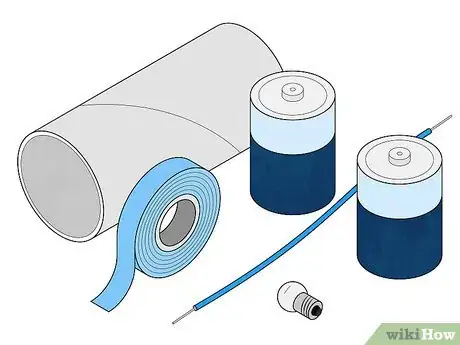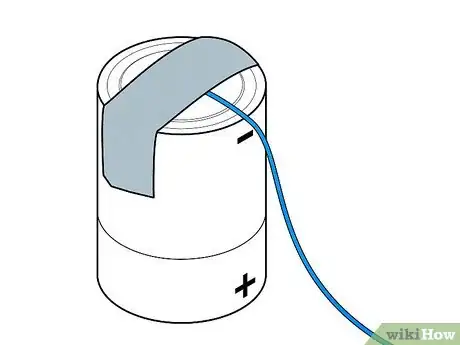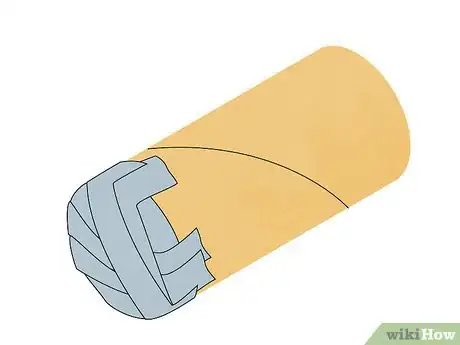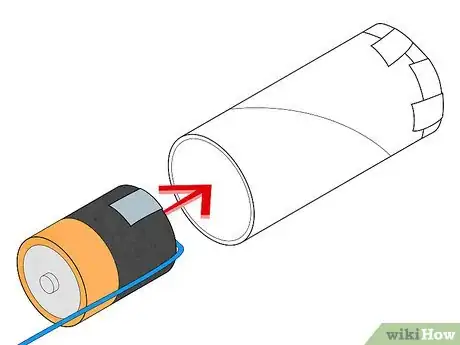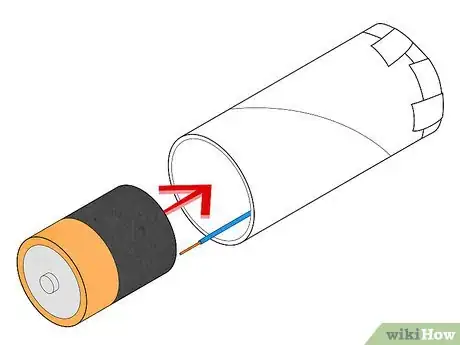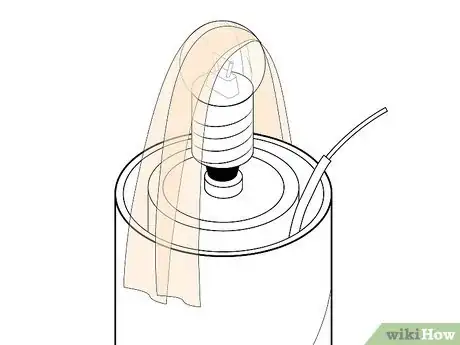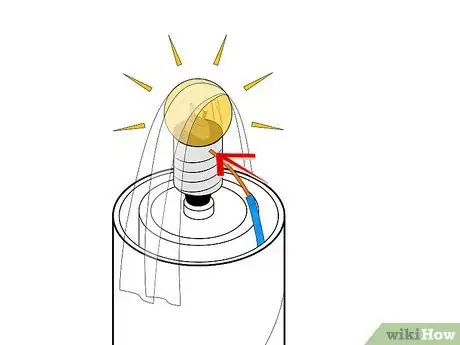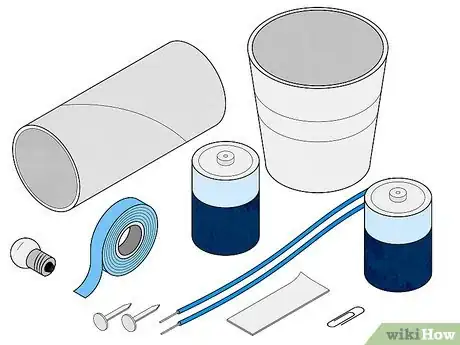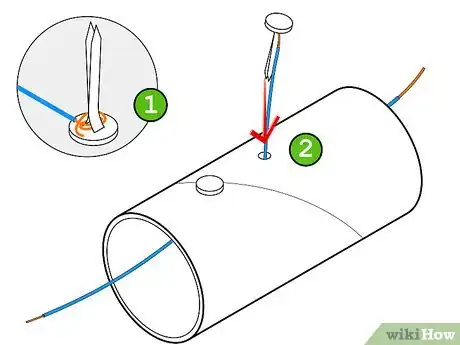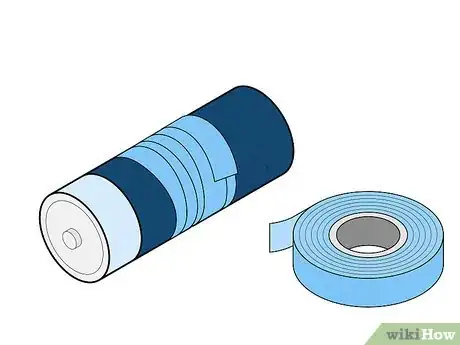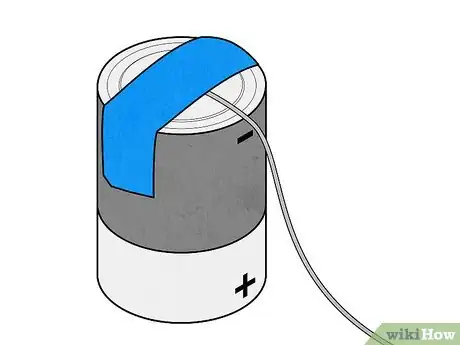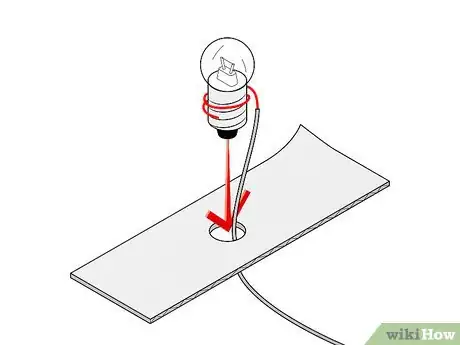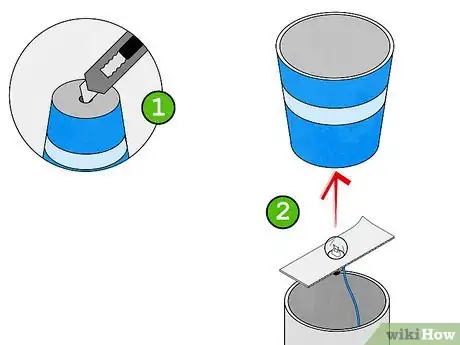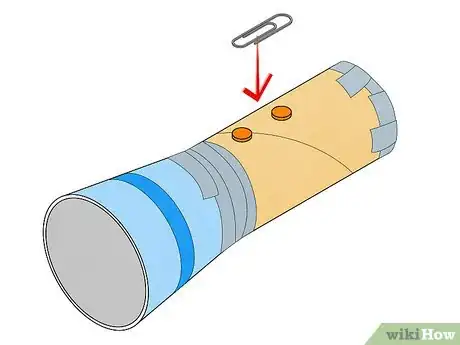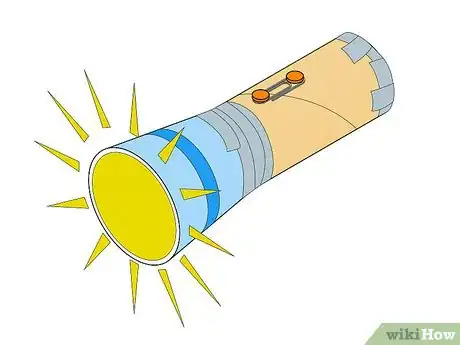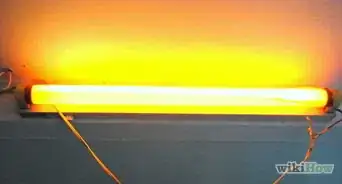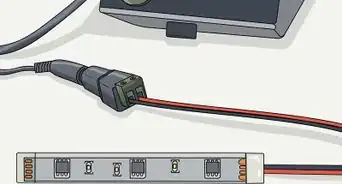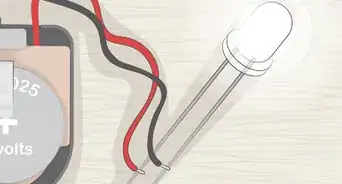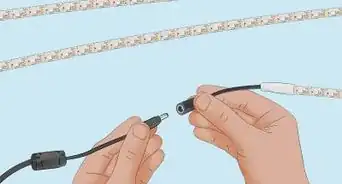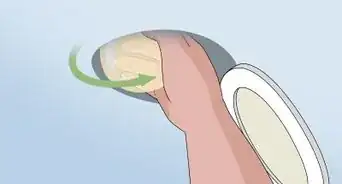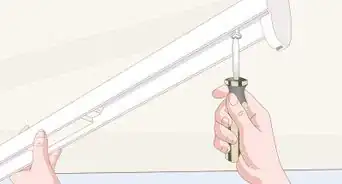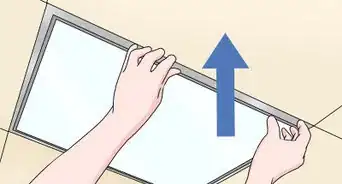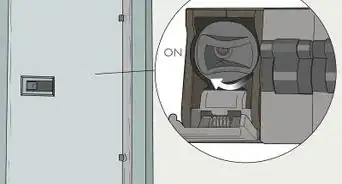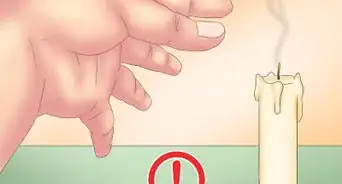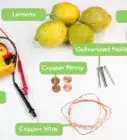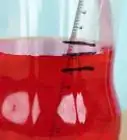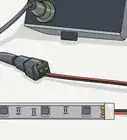wikiHow is a “wiki,” similar to Wikipedia, which means that many of our articles are co-written by multiple authors. To create this article, 87 people, some anonymous, worked to edit and improve it over time.
This article has been viewed 823,678 times.
Learn more...
There are plenty of flashlights on the market today - models that you shake, crank, twist, click, and more. If none of these flashlights tickle your fancy or you don't want to pay lots of money for unneeded bells and whistles, you can make your own flashlight from a toilet paper tube and other basic supplies you can find in your home.
Steps
Using a Quick & Easy Method
-
1Gather your supplies. Clear an area to work in and invite the kids and family to come watch you manipulate electricity with your bare hands. You'll need:[1]
- An empty toilet paper roll (or lightweight cardboard rolled into a small tube)
- (2) D batteries
- Tape (electrical tape works well)
- 5" (12.5 cm) long piece of wire (if you're using a speaker wire, use the copper kind)
- 2.2 volt light bulb (different bulbs are an option, but it may or may not work as well. A bulb from a string of Christmas lights works quite effectively.)
-
2Tape the wire to the negative ( - ) end of one of the batteries. Make sure it's snug and not going anywhere, or your light will end up flickering.[2]
- You could use tin foil instead of wire, but it's a little less dependable and harder to work with.
Advertisement -
3Tape the bottom of the toilet paper roll/cardboard well so that it is completely covered. You don't want any light to sneak through, dissipating its strength -- that would be one poorly working flashlight.[3]
-
4Insert the battery, wired end first, into the toilet paper roll. Even though the wired end is facing the taped bottom of the roll, the other end of the wire should be sticking out of the open end.[4]
- If the wire isn't sticking out enough to come around the edge of the battery, you need to shorten your tube.
-
5Insert the next battery, negative side first. Its negative side will meet the positive side of the battery, which is already inside. This connection continues the flow of electricity from back to front, ultimately lighting up your device.
-
6Tape the bulb to the top of the battery. Be confident there's an adequate direct connection between the two surfaces (basically, make sure it's sturdy). Make sure you can still see the bottom half of the bulb.
-
7Light up your flashlight. With the wire, touch the silver part of the bulb. If it doesn't light up after a few tries, check the tips below for troubleshooting. If it does function, now you have a working flashlight with an on/off feature.
Utilizing an Alternate Method
-
1Gather your materials. It's time to beckon the MacGyver within you and get started.
- 2 D cell batteries (separate)
- 2 5" pieces of number 22 insulated copper bell wire (1" of insulation stripped off both ends)
- Cardboard tube cut to 4" in length
- PR6, or number 222, 3-volt flashlight bulb
- 2 brass fasteners (brads)
- 1" x 3" cardboard strip
- Paper clip
- Tape
- Bathroom-size paper cup
-
2Attach a brass tab to the end of each wire. Wrap it around to secure it. Punch the tabs through the same side of the cardboard tube, but with the wires coming out of different ends. The pointy ends should be sticking out of the tube. This'll be used to serve as part of the on/off switch.
-
3Tape your two D batteries together. Make sure the positive of one end is on the bottom of the negative end. Your battery should double in length, not width. Make sure they're firmly attached to each other and slide the batteries into the tube.
-
4Tape the wire on the negative end to the battery. The negative end is the flat one. Masking tape is sufficient for this.
-
5Cut a hole in your small cardboard strip. Place the wire on the positive end through that hole and wrap that wire around the bulb. Place the end of the bulb into the hole so it can be supported by the cardboard.
- Place tape around the base of the bulb and cardboard to keep it secure to the wire. It should start flickering on at this point.
-
6Cut a hole in the bottom of a paper cup just large enough for the bulb. Place the bulb into the hole and secure the cup to the cardboard base with more tape.
-
7Insert a paperclip or soda tab in between the two brass tab ends. When the paperclip is touching both, it conducts electricity and turns your flashlight on. If the paperclip is moved, your flashlight will turn off. Voila!
- You can use a soda tab instead of a paperclip, too!
-
8Finished.
Community Q&A
-
QuestionWhy do I need to use two D batteries when making this flashlight?
 Community AnswerD batteries are generally bigger, so they won't move too much in the roll.
Community AnswerD batteries are generally bigger, so they won't move too much in the roll. -
QuestionWhat do I need to do if the light bulb doesn't light up when I touch it with the wire?
 wikiHow ContributorCommunity AnswerCheck the batteries' positive (+) and negative (-) sides. Connect one wire to the positive (+) and the other one to the negative (-) side. Check if the batteries are able to produce the required voltage that your light bulb needs to light up -- for example, if you have a 3V bulb, you need to produce 3V. If you have a battery that can produce 1.5V, then you need two of these batteries. That could be done by connecting two batteries, which will produce 3V (1.5V + 1.5V = 3V). Also, check your wiring; if the wires are messed up or aren't placed well, chances are they won't work. Try to tape them or use hot glue to permanently connect them with the batteries.
wikiHow ContributorCommunity AnswerCheck the batteries' positive (+) and negative (-) sides. Connect one wire to the positive (+) and the other one to the negative (-) side. Check if the batteries are able to produce the required voltage that your light bulb needs to light up -- for example, if you have a 3V bulb, you need to produce 3V. If you have a battery that can produce 1.5V, then you need two of these batteries. That could be done by connecting two batteries, which will produce 3V (1.5V + 1.5V = 3V). Also, check your wiring; if the wires are messed up or aren't placed well, chances are they won't work. Try to tape them or use hot glue to permanently connect them with the batteries. -
QuestionHow can I make this flashlight waterproof?
 Community AnswerCovering the flashlight with plastic wrap should protect your flashlight from the elements, at least for a little while. However, this will make it water resistant briefly, not waterproof, so don't take it swimming.
Community AnswerCovering the flashlight with plastic wrap should protect your flashlight from the elements, at least for a little while. However, this will make it water resistant briefly, not waterproof, so don't take it swimming.
Warnings
- Always do this with adult supervision.⧼thumbs_response⧽
- Be careful; the wire will get moderately hot.⧼thumbs_response⧽
Things You'll Need
Quick & Easy Method
- Empty toilet paper roll, or lightweight cardboard rolled into a small tube
- 2 D batteries
- Tape (works better with heavier duty tape)
- 5 inch long piece of wire (if you use speaker wire, use the copper variety)
- Desk, or a working space
- 2.2 volt light bulb (you can try different bulbs, but it may or may not work as well. A bulb from a string of Christmas or festive lights works quite well.)
Alternate Method
- 2 D cell batteries (separate)
- 2 5" pieces of number 22 insulated copper bell wire (1" of insulation stripped off both ends)
- Cardboard tube cut to 4" in length
- PR6, or number 222, 3-volt flashlight bulb
- 2 brass fasteners (brads)
- 1" x 3" cardboard strip
- Paper clip
- Tape
- Bathroom-size paper cup
References
- ↑ https://www.energizer.com/science-center/how-to-make-a-flashlight
- ↑ https://www.chromebattery.com/battery-kids/projects/build-a-flashlight
- ↑ https://betterlesson.com/lesson/639070/building-a-flashlight-preparation-day
- ↑ https://www.familyeducation.com/fun/indoor-activities/make-your-own-toilet-paper-tube-flashlight
About This Article
If you want to make a homemade flashlight, use electrical tape to attach a piece of wire, like copper speaker wire, to the negative end of a D battery. Tape the bottom of a toilet paper roll so it’s completely covered, then insert the battery, wired end first, into the roll. The end of the wire should be sticking out of the top of the tube. Insert the next battery into the tube, negative side first, then tape the bulb to the top of the battery. To light the flashlight, touch the silver part of the bulb with the wire. If you want to learn how to make a flashlight with a switch you can easily use, keep reading the article!
